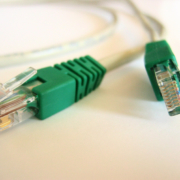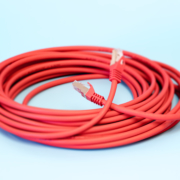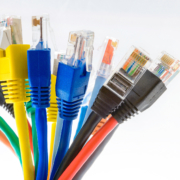CAT6 Ethernet Cable FAQ
What is a Cat6 cable?
Cat6 Ethernet cable is a data cable which is constructed of 8 separate cores that split into 4 pairs of colours. A Cat6 cable is classified as a twisted pair data cable. The pairs are twisted together and separated by colour groups, 4 pairs of different colours. Cat6 cable pairs are a combination of solid and white. Lastly, the 4 colours are Green, Brown, Orange, and Blue.
What is the Cat6 Speed?
The speed or frequency of a Cat6 cabler is 250Mhz. This is an increase to the speed produced by a Cat5e cable (100Mhz). In addition, Cat6 is capable of 1Gbps over 90m and in some cases it can reach 10Gbps over 55m.
What is Cat6 RJ45 wiring?
The standard connection for structured cabling is a RJ45. This connection is used for all categories, Cat5e, Cat6, Cat6a, Cat7 and above. The connector consists of 8 core colours which are separated into 4 pairs and twisted together. The colour groups are Green, Blue, Brown, and Orange. These colours match throughout the cable, module, and patch panel. As a result, regardless of the cable category, transmission still occurs.
What is Cat6e?
Currently Cat6e is not recognised as a standard of data cabling, it is not ratified by any of the standard boards regulating the structured cabling industry. Some manufacturers produce and sell Cat6e cables. The cable is classified as Cat6 enhanced. As the name suggests, the cable enhances the original capabilities of Cat6 from 250Mhz to 550Mhz. This is comparable to the ratified version of Cat6a.
How much is Cat6 cabling (Cat6 Price-Per-Point)?
Several factors will affect the total cost of your project. For example, building structure, available containment, location, and many others. Price per point should only be used as a rough estimation.
Price Per Point – £40.00 – £55.00.
For a detailed explanation of Price per point use this link
Cat6 is an advancement of Cat5e, the main difference between the data cables is the bandwidth. Cat6 has a bandwidth of 250Mhz in comparison to 100Mhz from Cat5e. Equally important, at the standardised 90m permanent link distance, both cables only transmit 1Gbps. Although this isn’t a standard length for data cabling design, Cat6 is capable of 10Gbps at 55m.
Cat6 vs Cat6a
Cat6a is the latter category of data cable after cat6. As previously mentioned, some manufacturers make a Cat6e cable. However, Cat6e has not been officially ratified by the standards board so it’s officially an advancement of Cat6.
The main difference between Cat6 and Cat6a is the bandwidth. Cat6a has a bandwidth of 500Mhz in comparison to the 250Mhz produced by Cat6. Additionally, at the standardised 90m permanent link, Cat6a can transmit 10Gbps. Cat6 can only achieve 10Gbps at 55m.
What is external Cat6 cable?
An external Cat6 cable is a data cable designed for outdoor installation. A standard Cat6 cable has PVC or LSOH sheathing, an external cable has a polyethylene (PE) sheath. The Polyethylene sheath provides protection from environmental factors such as moisture and temperature. For additional protection a steel armoured cable is used, PE sheathing doesn’t offer structural protection.
What is shielded Cat6?
Cat6 Ethernet cables come in various constructions. For internal cables there is an unshielded twisted pair known as UTP and a shielded twisted pair known as STP. The shielded version is similar in many ways to its counterpart but with additional foil shield around the cores of the cables underneath the outer sheath. As a result, it as an added layer of protection from external noise and EMI.
Can I run HDMI over Cat6?
Yes, Cat6 is a good choice to transfer HDMI signals. A transmitter sending the source HDMI signal is used to convert the signal over the cable. At the opposite end, a receiver is used to convert back from Cat6 to HDMI. Due to the increased bandwidth required for the AV connection some manufacturers recommend that a minimum of Cat6a is used.
What is a Cat6 coupler
A coupler is a through joiner where 2 plug ends of a cat6 cable are joined together through the coupler. It’s important to know, couplers commonly result in a loss of signal, therefore they are not recommended when extending Cat6 cables. However, if a temporary joint or an extension is required then the inline joiners are a better solution. They result in a lower loss of signal and better transmission speeds after joining.
What is a Cat6 junction box?
A junction box consists of two punch-down termination blocks joined within a single casing. A cat6 junction box is an inline joiner that can be used to extend two cat6 cables. Each of the two cables are terminated at opposite ends of the case and a permanent joint is created.
Can Cat6 run Gigabit Ethernet?
Yes. Cat6 cables are capable of gigabit ethernet up to 90m for a permanent link. This will be from the patch panel to the module. In addition, 5m parch leads can be used at each end. Lastly, a 100m direct link is allowed.
Can Cat 6 Run 10 Gigabit Ethernet?
Based on the standard 90m limit, Cat6 is not ratified for 10 Gigabit transmission speeds. However, the cable can achieve 10 Gigabit Ethernet up to 55m. As this is not part of the cabling standards, when designing a new installation, a 10 Gigabit ethernet requirement should be installed in cat6a and above.
What is the maximum distance of Cat6?
As general rule, regardless of category, all structured cables are ratified on their performance over a 90m permanent link. This allows for 5m patch leads at each end. In addition, a 100m direct link is permitted.
How to test Cat6 cables?
Cat6 cables can be tested in several ways, but the main test are. 1: A continuity tester. In this test the cable is tested, and 8 lights confirm if the 8 cores have been terminated correctly. Another key point, these testers do not give feedback about the transmission capabilities of the cable. With this test, you can’t determine the quality of installation or the quality of termination. 2: Fluke DSX, this cable certification tester shows charts that will highlight the performance of the cable. In addition, it highlights any effects of poor installation or faulty termination. Lastly, a cable certification tester will summarise if the cable can transmit as it should.





